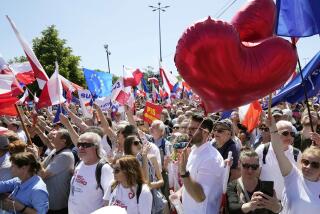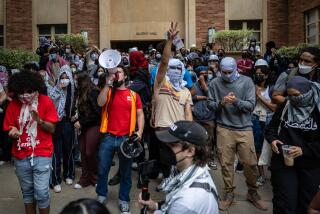Ethnic Relations : Piece-niks : A tough little band of activists struggles to build a democratic society, piece by piece, amid Croatia’s strife and hatred.
- Share via
ZAGREB, Croatia — Activists in Croatia’s anti-war movement don’t do marches. Staging a sit-in would never occur to them. That sort of thing is for peaceniks in the rest of Europe and the United States.
In Croatia--a country that exists with neither all-out war nor enduring peace--activists have to be more practical. “We can’t just say peace, brother,” said Zoran Ostric, the information officer for Antiwar Campaign/Croatia. “We have to be realistic.”
So, what began here as a spontaneous reaction to the outbreak of hostilities within the former Yugoslav federation has gone beyond helping conscientious objectors and publishing a Village Voice-like newspaper. Activists are aggressively tackling problems such as caring for refugees and in the process trying to influence the political debate on their nation’s future.
Shaking the Communist Party legacy, though, has pushed Croatia, like much of Eastern Europe, into a period of transition. Most media outlets here remain under state control, and a single party dominates most of the top political posts.
Still, the new nation has held free and fair elections and has an existing framework similar to many democracies, including a judiciary and legislature, according to Tia Pausic of the Croatian Democracy Project, a nonprofit group based in Washington that supports the development of democratic institutions.
The challenge, Pausic said, is to have these governmental organizations work “in a way that conforms with international norms of freedom and human rights.”
“Institutionally, things haven’t changed. Under communism, the party controlled everything. They just functioned in a totalitarian style. And people knew that. You more or less knew (for example) how a court case would be settled,” Pausic said.
“Now the problem is, you have to change the way the bureaucrats function and the way people perceive institutions. . . . That task has a lot more to do with changing mentality, than with changing laws.”
Srdan Dvornik, a peace movement organizer, put it more bluntly:
“People still know that a democracy is something else than what it is called by the leadership,” he said. “What they don’t know is that never in this world was democracy something ready-made--a gift. It was always something started with a fight for freedom, a fight for human rights.”
That’s where grass-roots efforts like those of the anti-war campaign come in. Using the anti-war campaign’s offices, telephones and funds, activists initially allied with the peace movement have expanded into campaigns that seek to minimize the ravages of war by bringing some sense of normalcy to refugees.
Founders of one such group, Suncokret, or “sunflower,” realized that although churches and other charitable groups were aiding the Croatian government in housing and feeding refugees, few had the staff and resources to organize social life at refugee camps.
So the organization, with about 220 volunteers from Croatia, Bosnia-Herzegovina and abroad, set up a network within 22 camps to provide games for children, libraries for teen-agers and ways for adults to pass the time.
We’re “trying to anticipate the impact of war on refugees. It was related to the fact that if you help the victims of war . . . you do a small bit for prevention,” said Nina Pecnik, Suncokret board president. “There was stress and emptiness. Those kids are aggressive even now. By being there . . . we hope to create other options for the children.”
At the Stobrec refugee camp in Split, for example, Michal Kroeber, 23, a German volunteer who came to the camp with the help of the Roman Catholic-affiliated peace group, Pax Christi, gave English lessons to half a dozen teen-agers and then handed out jump ropes to the younger children.
“I’m here for people--to listen to them. They are only living day-to-day. (The children) are happy if someone plays with them, teaches them,” she said. “It’s another way of working for peace, I think.”
But not all the programs at the camp, which houses 604 refugees, are aimed at children.
In the shade of chestnut and poplar trees, beside a white tent she calls home, Sevda Bolbozan, 45, judiciously knitted wool scraps into slippers, taking advantage of the yarn Suncokret donated. The task kept the woman from a village near Kalinovik--about 25 miles southeast of Sarajevo--and many other women working. It also provides an incentive: They hope to sell their handiwork for spending money.
Another woman from Bolbozan’s village, Fatima Besic, 53, said it was one of the few things that gave her hope. “We are so bored here,” she said. “We had everything, and look at us now. Now we have nothing to buy anything. Not even milk, coffee, detergent to wash ourselves.”
A visit by Western reporters to Stobrec prompted women to scurry from tents and trailers all over the camp, encircling the foreigners and eagerly foisting the bold reds, blues and greens of their sock-like slippers to the center of the ring, in hopes of persuading the outsiders to buy.
The co-leader of Suncokret activities at the camp, Irena Otasevic, 21, a former engineering and mathematics student from Sarajevo, cringed at the notion of being called a peacenik, regardless of Suncokret’s roots. She wants no part of people who visit the camp to hand out T-shirts and merely preach “peace now” to the survivors of war.
The refugees “didn’t bring the war, so they can’t bring the peace,” she said. “I’m not part of the peace movement. (Those activists) just come and take pictures--just like a zoo. They are war tourists.”
The emphasis on pressing needs rather than abstract goals can also be seen in the counseling and networking efforts organized by other groups with their genesis in the peace movement: the Center for Women War Victims and Zagreb Women’s Lobby. Vesna Kesic, a member of the coordinating team for the center in Zagreb, makes it clear that the ultimate aim is to open up the nation’s political dialogue.
“There are a lot of signs that (the ruling party doesn’t) like us,” Kesic said. “They’re certainly not happy about” the anti-war movement.
But “we don’t think we’re unpatriotic. (The government) thinks everything we should do should help the Croatian state. We don’t think so. . . . I think what I do is much healthier for a society than what they do.”
So far, activists say, their numbers and following are too small to be of much concern to those they challenge. One Croatian government information officer, when asked his opinion of the peace movement newspaper, ARKzin, claimed he had never even heard of it.
The newspaper, whose name comes from the acronym in Croatian of the words anti-war campaign , features articles from Serbs as well as Croats and is often critical of the mainstream media and the regime.
But Croatia’s government and the ruling party, the Croatian Democratic Union, have so far made no move to complain about their work. Though Ostric said he was once threatened by a government official because of his views, the activists, by and large, work unhindered in an upstairs office in Zagreb.
Their four-room flat is decorated with a U.N. flag hanging from the balcony and a white sheet with a peace symbol and nature drawings on the door. There, the volunteers lay the groundwork for conflict mediation and reconstruction projects in areas devastated by conflict.
They also draw attention to human rights issues. It was the anti-war campaign, for example, that complained to the Ministry of the Interior when Muslim refugees were rounded up and deported to Bosnia-Herzegovina from Croatian refugee camps in August.
But to Ostric and Dvornik, their work is only a beginning. Even if hostilities were to end immediately, they said, it would be only the first step in the struggle for a normal life in a democratic society.
“We are for peace. We are for human rights,” Ostric said. “You cannot have a free nation if every individual is not free. You must work continuously. You must fight.”
More to Read
Sign up for Essential California
The most important California stories and recommendations in your inbox every morning.
You may occasionally receive promotional content from the Los Angeles Times.










